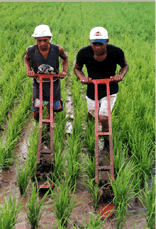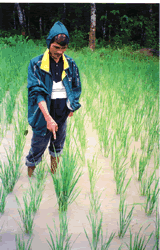ECO-RICE: Radically Redesigning Rice
The 'Green Revolution' of the 1970s was led by the development of new plant genetic materials that responded favourably to intensive growing conditions with high levels of pesticide and fertilizers inputs. In the short term it led to dramatic increases in productivity. More recently, yield increases have been less than remarkable and the many problems associated with the green revolution approach are now well recognized. In the case of rice farmers in the Philippines, soil fertility declined, agricultural and ecosystem biodiversity was decimated, and many small farmers suffered from serious indebtedness and severe health problems from using large quantities of chemical inputs. |
| Rice weeders used in the production of organic rice |
The three main system components being integrated to develop ECO-RICE are:
- System of Rice Intensification (SRI).
The SRI system evolved in Madagascar in 1983 by a priest, Fr. Henri de Laulianie, who sought to create the best possible growing environment for rice. His research showed an increase in productivity when the rice was grown in well-drained soil during the vegetative growth phase, with individual seedlings transplanted to the field early, and the rice was planted at wider spacings (25-50 cm rows). - Lock Lodge Ratooning
Recent research on the new ratooning technique of lock lodging, where the stems are broken over at the base, has increased yields by 95% compared to conventional ratooning when the crop is mowed and allowed to regrow. Under lock-lodging, yields of promising ratooning varieties are approximately 75% of conventionally grown crops. This practice advances the harvest cycle by about 25-35% compared to a conventionally prepared crop (10 days between crops) or 35-43% when a 30 day period for straw decomposition is practiced. Significant advantages to farmers include reductions in input costs of 50-60%, reduced indebtedness (as harvest cycles are faster and input requirements lower), reduced labour and farm draught animal requirements, greater cropping flexibility and reduced risks for crop losses from heavy typhoons and droughts. - BNF and/or Nitrogen Use Efficient Varieties
The selection of rice for BNF and/or efficient N using varieties can be best achieved if the rice is selected under SRI management and unfertilized conditions. Under SRI, the system produces larger plants and volumes of biomass as well as aerobic soil conditions that support beneficial bacteria. Having a nitrogen limited soil environment enables the plants to better express their differences in adaptability to N restricted growing conditions.
 |
| ECO-RICE selections are made under low fertility soil conditions which enable farmer breeders to readily identify rice strains with improved N nutrition |
| Growing Days | Fallowing Days | Ratooning Days |
| Conventional High-Yielding Rice Varieties - 285 days ( 3 crops ) | ||||||
| 95 | 10 | 85 | 10 | 85 | ||
| Organic Rice - 255 days ( 2 crops ) | |||
| 115 | 30 | 110 | |
| ECO-RICE - 275 days ( 3 crops ) | |||
| 115 | 80 | 80 | |
With the many advantages of ECO-RICE, including increased productivity, enhanced food security, and reduced poverty, it is hoped that more research will be targeted towards such ecological production methods and eventually ECO-RICE can become a mainstream reality.
To learn more about ECO-RICE, refer to the Philippine documents in our on-line library.
Other Philippine Activities include:
- Development Projects using the Agro-Ecological Village Model
- The Mayon Turbo Stove (MTS): Reducing Poverty and Greenhouse Gas Emissions in the Philippines
- Ecological Sugarcane Farming: From Sugarcane Monoculture to Agro-Ecological Village




